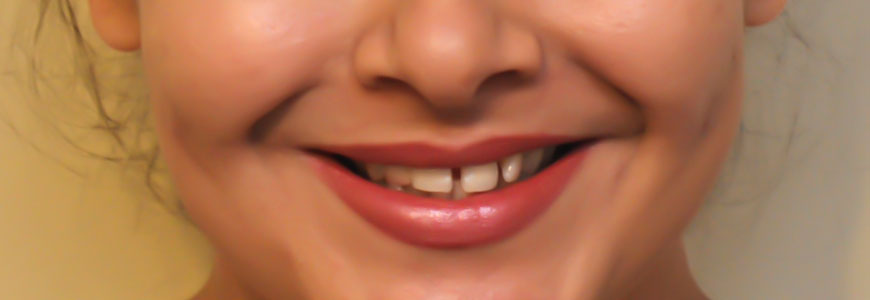
With age, our teeth have a tendency to shift and a gap between the teeth may slowly appear. If you have a tooth extracted which is not immediately replaced with an implant or bridge, your entire bite may shift dramatically. The teeth surrounding this missing tooth may shift toward each other, creating a gap between the teeth. It's not at all unusual for people who had terrific smiles their entire life to suddenly notice that they have developed gapped teeth.
For some, a very small gap between the front teeth can be charming, even attractive. Anything larger than the faintest of gaps, however, is usually regarded as unsightly. Of course, gaps that occur between teeth other than the two front teeth are completely undesirable. For instance, a gap between an incisor and a canine is quite noticeable and very awkward looking.
Childhood habits can also lead to gaps between the teeth. Thumb sucking tends to pull the front teeth forward, creating gaps between teeth. Spaces can also develop from an incorrect swallowing reflex. Mostly the tongue presses against the roof of the mouth (palate) during swallowing. Some people develop a different reflex known as a tongue thrust. When they swallow, the tongue presses against the front teeth. Over time the pressure will push the front teeth forward. This can cause spaces to develop. Periodontal (gum) disease results in the loss of the bone that supports the teeth. In people who have lost a lot of bone, the teeth can become loose. This movement can result in gaps between the front teeth. Children may have temporary gaps as their baby teeth fall out. Most of these spaces close as the permanent teeth reach their final positions.
Teeth Effect Bands
Teeth Effect bands work by wrapping around the teeth which are having the gap between them. The band has the ability to stretch. When it is placed on the teeth it stretches to its full limit. Now the stretching takes its reverse action by putting the teeth together. This slowly reduces the gap. The advantage of using teeth effect bands is affordability and there is no requirement of going to the dentist.Porcelain Veneers
Porcelain veneers are very thin transparent shells, made of porcelain and they are placed on both tops and front of the teeth. The transparency of porcelain veneers allows light to pass through and they can easily expose the natural colour of the teeth under them. They are durable and strong it will be impossible to detect its presence over the teeth.Bonding
Bonding involves a three step procedure. First a mild acid is applied on the front of the teeth, and then a plastic bonding material is placed and sculptured according to the shape of the teeth. The last step involves use of a high density light which hardens the material.Orthodontics / Braces
Braces or orthodontics are very effective, but the process can be a little uncomfortable. There are small brackets used in orthodontics and the front of teeth is bonded with them. Then wires of different sizes are used to connect the brackets so that the teeth are moveable and gaps can be closed. No tooth reduction is required when setting braces.Crowns
Crowns are very commonly used solutions for closing gap between teeth. They can be made of either metal, porcelain or both of them together. They are the best solution in case of broken teeth, especially where protection and support is required. If the gaps between your teeth are extremely wide, crowns are a better solution. Crowns are very strong and several materials can be used to fabricate them.- Keep your teeth clean by brushing and flossing daily.
- Schedule regular professional cleaning by your dentist or dental hygienist.
- Use a gentle toothpaste that is safe for bonded teeth. Your dentist can make recommendations.
- Slice hard foods like apples and carrots before eating them.
- Avoid biting on hard objects like fingernails, pencils, or paperclips.

